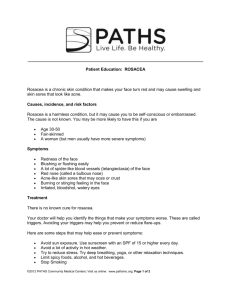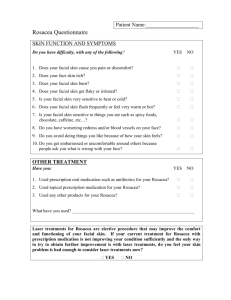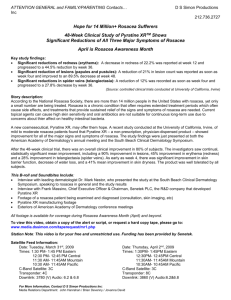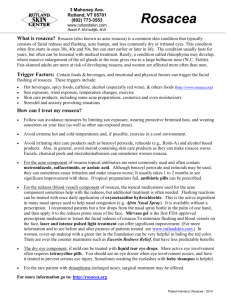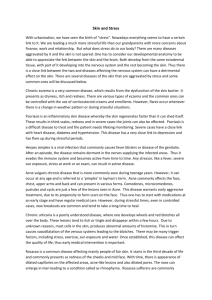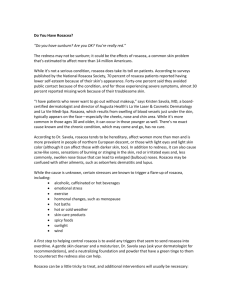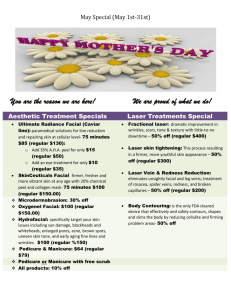Global Perceptions Survey Report
advertisement
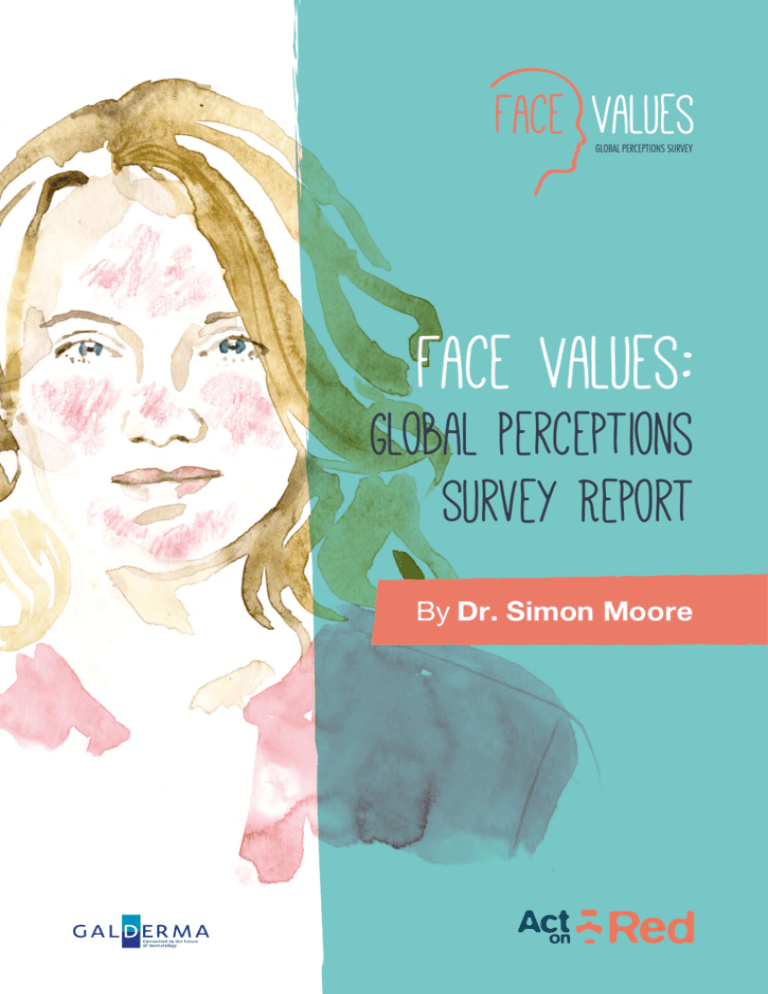
Face Values: Global Perceptions Survey Report By Dr. Simon Moore Face Values: Global Perceptions Survey report Foreword A ll illnesses bring with them a multitude of life changes and challenges that need to be addressed if one is to cope with their condition effectively. In the case of dermatological conditions, these challenges are further complicated by the conspicuousness and visibility of symptoms. In a society where attractiveness is positively related to expectations of future success, happiness, and even satisfactory social relationships, it is not surprising that those suffering with dermatological conditions often experience high levels of self-consciousness and a lowered sense of quality of life and self-esteem. The area of psychodermatology holds not only a professional but also a personal relevance for me. I first became interested in the field when my cousin whom I was very close to developed a progressive skin condition as a teenager. I found it fascinating how profoundly a condition, which was not believed to be painful or limiting in any way, impacted upon her life, her decisions and even the way she saw herself. Like so many others who experience a skin disease, she began to be defined by it, to be stigmatised by it and to let it dictate her behaviour and even her quality of life. Over the years working in the area of psychodermatology, both as a clinician counselling patients and as a researcher, I have seen this process enacted many times. The effects of skin conditions are much more than skin deep. Dermatology patients need to adjust not only to the medical and sensory challenges of their illness but also to a new body image. They must learn to cope with the challenges of living with an appearance that deviates from the norm and they need to make sense not only of their own reactions to their condition but also deal with the reactions of those around them as well. The visibility of skin conditions makes them unique, as the choice of sharing your illness with others is often not available. Indeed, in many cases other people’s reactions to one’s illness can be one of the hardest things to cope with. To complicate things further, conditions like rosacea often go undiagnosed for a long time. We are socialised into avoiding doctors unless absolutely necessary and therefore many people avoid seeking medical advice for years. The fact is that receiving a diagnosis is vital if rosacea sufferers are to make sense of their condition, mitigate its impact on their quality of life and manage their symptoms effectively. Sadly many sufferers delay getting a medical diagnosis for their condition, meaning that not only do the physical symptoms of the conditions remain unaddressed but the psychosocial impact is also left unrecognised. This is why I was delighted to provide the foreword for the Face Values: Global Perceptions Survey as part of the Act on Red programme. This report on the cognitive representations and psychosocial ramifications of the condition provides insights and information for both those experiencing the condition and those working with it. It explores social bias against sufferers and how such biases affect the patient experience. Illnesses do not occur in a vacuum and if we are to treat them effectively we need to look at them not only from a physiological perspective but from a psychosocial one as well. We need to treat not only the illness, but the person experiencing the illness, and that is what the Act on Red programme helps to address. Dr. Linda Papadopoulos BA (Hons), mSc., PhD., CPsychol., CSci., AFBPsS Face Values: Global Perceptions Survey report Executive Summary S kin. It’s a fascinating topic. As the largest organ of our body, it serves as a boundary between our physical selves and the outside world. It is also the first thing people see when they look our way. Our skin has the ability to reveal our mood, health and, like it or not, our age. So how do we feel when something goes wrong with our skin? Unsurprisingly, the link between skin and psychology is a strong one. In fact there is an entire field called ‘psychodermatology’ that considers the psychological impact of skin diseases. The Face Values: Global Perceptions Survey is a piece of research aimed at contributing to this growing body of work. Commissioned on behalf of Galderma, the research focuses on the impact that facial redness associated with rosacea can have on people’s perceptions. Rosacea is a chronic inflammatory skin disease that affects over 40 million people worldwide and facial redness is a very common symptom for people with rosacea.1,2 For many people who suffer from rosacea, the associated facial redness is a prominent and visible hallmark of the condition. These individuals often assume they blush easily or that they are just very sun-sensitive but the redness is distinct – a characteristic pattern that mainly affects the centre of the face, cheeks, nose, chin and forehead.3 As a recognised disease it is something that should be taken seriously – but exactly how seriously does facial redness affect a sufferer’s emotional and psychological wellbeing? That’s the first question we set out to answer. Previous studies show that sufferers are often affected by emotional disturbance and social stigma, and many report depression, anxiety, embarrassment and lowered selfesteem.4,5 Our research confirmed these findings – facial redness associated with rosacea can be a worrying and distressing condition. Sufferers were less happy with their skin appearance, suffered emotionally, socially, at work and in their relationships as a result of their condition compared to non-sufferers.6 Of course, the challenge with skin is that when you notice you have a problem it feels like everybody else must do too. That’s why there is a second side to our survey. We wanted to find out the true impact of facial redness on the perceptions and reactions of other people: Fear, pity, indifference? We all want to believe that we judge individual characters on more than their looks, but it is hard to deny that first impressions count and snap judgements (often formed subconsciously) are an important part of our day-to-day interactions. To answer this second question we assessed a cross section of people’s initial, automatic and subconscious perceptions of images of people with facial redness using a specially developed test called Emotix©. This online engine was used to flash-up images of red or non-red faces and respondents were asked to associate either positive or negative words with each one. We also asked respondents a series of questions about their attitudes towards images of sufferers versus non-sufferers. Together, the findings showed that people with facial redness are judged more negatively than non-sufferers and thought of as less trustworthy, less reliable and less confident. However, the news is not all bad. What our research also served to highlight was that once facial redness is managed, often as a consequence of a professional diagnosis, rosacea sufferers feel better and more in control of their facial redness. Understanding the triggers and finding appropriate treatment to help gain control over their facial redness might be the motivation sufferers need to seek advice from a doctor or dermatologist, because the condition is a manageable one. As you read the outcomes of the Face Values: Global Perceptions Survey, take a moment to consider how your own preconceptions can influence the way you think about a person, particularly when you encounter somebody with a skin disease. Are you unfairly drawing negative conclusions? Having read the report, perhaps you might stop for a moment to consciously consider your first impressions, because taken at face value, they might not be quite as reliable as you think. Dr. Simon moore BSc (hons), phd., CPsychol and member of the British Psychological Society who did we ask and what did we ask them? The Face Values: Global Perceptions Survey involved nearly 7,000 adults across eight countries with data collected from a representative cross-section of people.* Participants (aged between 25 and 64), completed a bespoke psychological assessment, Emotix©,† which is based on the well-established psychological test, the Implicit Association Test (IAT). asked to associate or discard words shown next to each image, with the speed of their response directly linked to their initial, subconscious perception of the face appearing on screen. Following the Emotix© test, respondents were also asked a series of questions comparing their attitudes towards further images of sufferers versus non-sufferers via a traditional questionnaire. The respondents identified with rosacea via screening questions were asked a further set of questions about their views of living with the condition and how it impacts on various aspects of daily life including their emotional and psychological wellbeing. what Are Implicit Associations? As you look at someone with facial redness, you start to make certain judgements. Without you even noticing, bias and preconceptions have quickly begun to influence your thoughts. IAT describes your immediate, subconscious reaction to the person. Emotix© is specifically designed to capture those attitudes and beliefs that we hold but that we often do not voice due to social or political conformity, peer pressure and politeness. It is built upon statistical modelling and the latest understanding of neuroscience and decision making processes. Emotix© has been seen to be scientifically robust, reliable and valid in gathering individuals’ otherwise hidden attitudes and beliefs in a number of situations such as consumer and health behaviour.7-9 It highlights the difference between system 1 decision making (fast, intuitive, subconscious and emotional) and system 2 decision making (slow, considered, vetted, socially acceptable and rational).10 Assessments based on implicit attitudes seek to isolate and identify this initial, subconscious response. During the Emotix© assessment, participants were presented with images with and without facial redness.‡ Respondents were Country number of participants 6,§ Examples of images shown to respondents. Northern European male and female images, with facial redness (left) and without facial redness (right) * The global research was conducted by Bryter, an independent market research consultant, between 31 October and 18 November 2013 † Emotix© test developed by Innovation Bubble ‡ The models used within the survey did not suffer from facial redness – the images were digitally retouched to accurately represent the typical facial redness pattern associated with rosacea and verified by a dermatologist § Quotas were set by age, gender and geographic region to ensure reliable and accurate representation of the population from each country 3 Face Values: Global Perceptions Survey report what did we find? You might not be surprised to hear that people with facial redness associated with rosacea don’t always create the best first impressions. But what you may not have realised, is just how strong this disadvantage appears to be. Results from the Emotix© test showed that on first impressions, faces with redness compared with non-red faces were judged to be:6 • In five countries (Denmark, France, Germany, Ireland and Sweden), it was the women who were subconsciously more critical about the images of facial redness than the men And what about self-reports from rosacea sufferers?6 These results were reflected by first-hand reports from sufferers. Respondents were clearly concerned about how the condition was negatively impacting their daily lives: • 12% reported having facial redness associated with rosacea, yet approximately only one in 10 of these people have been diagnosed by their doctor or dermatologist Other interesting results from the research:6 • When shown an image of a person with facial redness, almost eight in 10 respondents (77%) noticed the appearance of skin before anything else. This is three times higher than for an image of a person without facial redness • Negative first impressions of people with facial redness also included opinions about their lifestyles: • People are less likely to consider being their friend • Less likely to believe they’re in a relationship • Less likely to think they have a professional job • Less likely to hire them • Only 29% were happy with their skin and consequently their overall appearance (compared with 63% of those without the condition) • Most felt embarrassed by their facial redness and reported significant impact emotionally (77%), socially (67%), at work (63%) and in regards to relationships or dating behaviour (53%) 77% 63% 67% 53% impact emotionally impact socially impact at work impact relationships • Almost eight in 10 (78%) found the condition unpredictable and difficult to control • Seven in 10 would give up something to be rid of facial redness – they are willing to make sacrifices in exchange for eradicating the condition • Many sufferers are motivated to alleviate their symptoms. They are also likely to consider or have tried a variety of lifestyle changes and cosmetic approaches in an effort to manage their facial redness fluctuates between periods of remission and exacerbation.13 At the onset, redness, small pimples and broken blood vessels usually appear on the face. Over time, the redness tends to become ruddier and more persistent, and visible blood vessels may appear. Left untreated, bumps and pimples often develop, and in severe cases the nose may grow swollen and bumpy from excess tissue.2,12 How do you know if you have it? Take note! Our survey indicated that those with diagnosed rosacea were significantly more likely to have their symptoms under control (39%) than those with symptoms not yet diagnosed (20%). This suggests that medical acknowledgment and appropriate treatment are crucial in improving the lives (as well as the first impressions) of sufferers.6 So what exactly is facial redness associated with rosacea? Facial redness associated with rosacea is sometimes difficult to recognise. Many individuals ignore their symptoms which they presume are the result of their sensitive skin or an allergic reaction. Some believe they are suffering from excessive blushing. However, one simple way to identify the signs of facial redness associated with rosacea is the characteristic pattern of redness that mainly affects the centre of the face, cheeks, nose, chin, and forehead. There are known typical triggers such as sunlight, alcohol, hot and spicy food, extreme changes in temperature or exercise, which can cause a facial flare-up or worsening of the symptoms.14 Understanding and identifying these triggers is the first step in helping the problem. Ultimately rosacea is a treatable condition, with solutions available for each symptom, including facial redness. Flushing from embarrassment? Evidence of exertion after sport? For many of us, a temporary discolouration in the skin is normal – certainly not something to worry about. In contrast, facial redness is a common medical symptom of a chronic inflammatory skin called rosacea.1 Rosacea is the medical term for a specific disease with different types of independent or combined skin problems, mainly of the face. It is typically characterised by flare-ups and remissions. Rosacea can be divided into four distinct subtypes (with each one varying in severity from mild to serious), with facial redness being a common symptom for all subtypes.2 Potentially life disruptive, and often progressive, the disease occurs mostly in patients between 30 and 50, and should not be confused with acne.5,11,12 The severity and nature of rosacea symptoms varies between individuals and typically And what can be done about it? There is no ‘magic cure’ for facial redness associated with rosacea, but there are a number of ways sufferers can control and live with their condition. Prescription medicines, skin care regimens and avoidance of triggers can all help people to manage their rosacea, reduce burden and prevent their symptoms from worsening.15 5 Face Values: Global Perceptions Survey report How does it make you feel? Most of us have experienced a bad skin day before. Maybe you had acne as a teenager, or as an adult are self-conscious about wrinkles. Whatever your particular worry, there is one thing we can all agree on: when you don’t feel confident about your face, it is hard to feel confident at all. Much research has been conducted to examine how rosacea impacts on the emotional and psychological wellbeing of a sufferer. Previous studies have shown that overall the effect is negative, in line with the results presented in the Face Values: Global Perceptions Survey.6,16 These studies have shown that rosacea sufferers have felt lowered self-confidence and self-esteem and find it harder to establish new relationships. The thought of having to present or participate in a face-to-face meeting can be daunting, even more so for a rosacea sufferer, leading to cancellation and avoidance.17 face-to-face meeting can be daunting The impact on a sufferer’s working life is real with a significant proportion of sufferers saying they missed work due to their rosacea and many feeling they were prevented from being selected for a new job.17 so in conclusion... We are only human – we worry about how other people see us. For those suffering from skin conditions such as rosacea, not only can this concern have a negative impact on general wellbeing, it can impact how they live their day to day lives. what lies behind our first impression of others? Fight or flight? Or fight fLight It is well-established that elements of human behaviour can be traced back to the actions of prehistoric man. In earlier times, the natural reaction to meeting someone new was to quickly scan them for any signs of visual threat. Do they look hostile? Do they want to steal my food? Will they hurt my family? Our lives today may be less dramatic, but the same principles apply. Making quick judgements about someone’s visual appearance is a basic defence mechanism. Who is this person? What do they mean to me? Should I be worried? Since we can usually see further than we can hear, it is no great surprise that we put our eyes to good use. Even though most of us realise that a first impression based on appearance doesn’t reveal a person’s entire character, in that instant it is often the best detective tool we have. Cognitive clues So we use first impressions to simplify decisions about our immediate safety. But what is actually happening inside our brains at that moment? Everything comes down to cognitive representations – all the knowledge we have stored inside our memory. When we first meet people we start searching for cognitive clues. Does this image fit with the knowledge I have of a good person? A risky one? We are looking for pointers that make the world an easier place to classify, organise and understand, allowing us to take action whilst minimising risk. Social stereotyping 2. There is a psychology behind the way that rosacea is perceived by others Our underlying behaviours may have been shaped by distant ancestors, but the modern world has a huge influence on our actions. The obsession with sharing personal photographs online, the constant photographing and analysis of celebrity bodies, like it or not, we live in a society that pays disproportionate attention to the physical. We associate beauty with success, health and power. In fact studies have shown that whether you show a photo on your social media profile, or how attractive your photo is judged by others can influence how they rate you in terms of your work skills and personality.18-20 • Many observers make assumptions about character traits and behaviour habits when they see reddened skin – they tend to ‘judge books by their covers’ So what is the psychology of rosacea? Any psychological analysis of facial redness associated with rosacea must address two key points: 1. Psychological factors might actually be one of the triggers causing the problem in the first place! • Recent research has revealed that a person’s emotional state may in fact contribute to the onset of a rosacea flare-up – particularly if the person feels stressed due to family or work problems21 family • These attribution errors set up a negative feedback loop – when rosacea sufferers are viewed by others in a certain way, they start to act that way so that’s the theory But what’s the reality? The Face Values: Global Perceptions Survey has revealed a number of fascinating trends and tendencies, many of which provide further evidence for the psychological science we’ve presented. Over the following pages we delve deeper into the detail of the results, discovering statistics and opinions that will not just be of interest to rosacea sufferers, but to anyone who has ever judged a book by its cover… woRK • In a US National Rosacea Society survey of 748 rosacea patients, 69% said they experienced a rosacea flareup at least once a month corresponding to ‘peaks’ in emotional stress21 69% 7 Face Values: Global Perceptions Survey report the detail: what our survey said How common is facial redness associated with rosacea? what were the key themes from the survey?6 1. Facial redness tends to generate a negative first impression • When looking at someone with facial redness, almost eight in 10 people notice their skin before anything else. This is three times higher than when assessing a person without facial redness. It is estimated that one in 10 of the population suffers from rosacea, though the incidence of the disease varies across the globe.22,23 Figure 1: What did respondents focus on most when they viewed the pictures? Significant difference between samples at the 95% confidence level (p<0.05).6 • The results of the Face Values: Global Perceptions Survey reaffirm this figure – 12% of those surveyed selfreported rosacea6 • However, the survey also showed that only about one in 10 of those respondents with symptoms have received a formal rosacea diagnosis from their doctor or dermatologist6 12% 10% Reported having facial redness associated with rosacea Diagnosed by their doctor or dermatologist why so few diagnoses? It seems that awareness of the condition is low – or at least that facial redness is an under-recognised symptom of rosacea. why does this happen? Earlier we mentioned how ingrained habits can influence our subconscious actions and behaviours. A similar theory applies here. As humans we are natural predators, our visual system is directed straight ahead of us, with our eyes at the front of our faces. Therefore it is not surprising that a disproportionate amount of our brain stimuli receptors are geared towards visual decoding. Furthermore, our brain is particularly sensitive to spotting negative stimuli (or anything abnormal or unexpected).24 In fact we pay faster and more detailed attention to the bad than we do the good. Which makes sense if you are using visuals to signal the safety of a situation – focusing on the negative allows you to identify and respond to potential threats more quickly. In our survey, the red faces were likely to be seen as ‘unexpected’ or ‘out of the ordinary’. The images may have triggered alarm in respondents – they sat up and paid attention to a potential risk, noticing more than they normally would. In general, when we view something that falls outside our ‘safety zone’, we tend to react to it much more quickly and then subsequently, spend more time and effort evaluating it. So now we understand why the skin of rosacea sufferers may be judged so quickly – it is seen to be abnormal. However, that is not the only hurdle for people with facial redness. Wherever it appears, the colour red is most often associated with danger, alarm and threat. So when it appears on your face… the impact is even more profound. In Figure 2 we can see how this sense of danger is reflected in the participants’ responses. Figure 2: Respondents attitudes to photos with and without facial redness.6 Significant difference between samples at the 95% confidence level (p<0.05). 9 Face Values: Global Perceptions Survey report Faces with redness were evaluated less positively than faces without. The overall impression was that rosacea sufferers were: Just how unaware are we of this negative response? The Face Values: Global Perceptions Survey made use of the Emotix© assessment, based on a well-established methodology to measure people’s intuitive, subconscious perceptions. Below, Figure 3 shows how words and phrases presented in the Emotix© assessment that related to poor health were immediately associated with images of facial redness by respondents. Whereas words and phrases relating to positive personality characteristics were more strongly associated with clear faces (Figure 4). And what did most respondents believe those with facial redness should do to improve their social standing? One word: skincare. Figure 3: A comparison of the strength of intuitive responses of health-related words associated with both clear and red facial images. Figure 4: A comparison of the strength of intuitive responses of personality-related words associated with both clear and red facial images. A score nearer to 100 indicates a very strong intuitive association between the word and the face – while a score of 0 indicates no association. The difference in the strength of these associations between the faces are all statistically significant (p<0.05). The linking of the stimuli words with the facial images that appear in the Emotix© test reflect how strongly participants intuitively attribute personal characteristics to the owners of the faces. It seems that from the very first glance, we assign significantly different characteristics to red faces than clear ones. Looking at the list of personality attributes, you will notice that not only are those with facial redness judged to be physically inferior, they are also deemed to have less positive non-physical traits. Does the health of your skin really change how people view your intelligence or assess your trustworthiness? According to our survey, yes. The halo effect and why ‘beautiful’ is perceived as good The images of non-reddened faces were thought to be more outgoing and more reliable. Why? In psychology this is known as the ‘halo effect’. It occurs when one significant feature of a person influences subsequent evaluations of other characteristics. In the case of the faces with redness, the individuals are being judged as ‘not normal’ and therefore not as attractive as the clear faces. The halo effect then takes this negative impression and transfers it onto the evaluation of the eyes, the nose, the mouth etc. Which seems to imply that even if a person with facial redness has the nicest smile in the room, chances are that respondents would not evaluate it positively because they have already initially formed a negative impression about the rosaceaaffected face. Then we have the phenomenon that psychologists refer to as ‘what is beautiful is good’. This is the tendency human beings have to associate anything good-looking and attractive with positive personality traits, and anything less pleasing to the eye with negative traits. You might not think this applies to you but have a quick think about your favourite books or movies. Are the heroes and heroines attractive and the villains bitter and twisted? Now consider how this could apply to those suffering from facial redness. If, as our survey showed, people all around the world are habitually rating attractive individuals more favourably, then not having clear skin could prove to be a real disadvantage. Not only do reddened faces create negative physical impressions, but these impressions are being unfairly interpreted as evidence of negative personality traits. The female of the species We all know that men and women sometimes think differently. But how does this apply to their reactions to facial redness associated with rosacea? The Emotix© assessment revealed some fascinating variations between male and female responses: • In five of the eight countries tested (Denmark, France, Germany, Ireland and Sweden), a significant gender difference emerged. For certain characteristics, female respondents were more critical and less positive about the faces with redness than their male counterparts What could be the reason for this? Well there are different theories, and more research is needed before any definitive conclusions could be drawn. But here are some possible ideas: • In many cultures, females are conditioned to care more about their own attractiveness. Society and the media judge them almost entirely on the basis of their physical appearance, giving them the message that they must ‘look good’. Females internalise the constant bombardment of gender propaganda from brands and advertisers, with the result that visual appearance becomes an accepted and even over-emphasised criterion for evaluating others • ‘Women’s intuition’ has long been lauded as a proprietary characteristic of the fairer sex. Could the reason that females are more critical be down to the fact that they actually are more perceptive? It is an intriguing possibility, but one that certainly requires further study 11 Face Values: Global Perceptions Survey report 2. Facial redness tends to have a negative effect on sufferers both personally and professionally According to our research, there are clear psychological consequences for people living with facial redness: How do other people see things? As we might expect, other people have quite similar opinions to sufferers themselves. The results of the Emotix© assessment clearly highlight that people’s perception of rosacea’s effects are overwhelmingly negative. Respondents associated facial redness images with decreased happiness, confidence, insecurity, sadness and stress.6 A vicious circle By now the interpretation of these results may begin to sound familiar. Humans naturally attach importance to physical appearance, a trait that our modern image-obsessed society has provoked. We often link our personality and psychological wellbeing (and that of those around us) to the way that we look. It seems that our general sense of selfawareness, identity and value can be found when we stand in front of the mirror. In fact we feel less confident in work interviews, on dates, and as socially persuasive people if we judge ourselves to be ‘not looking my best’. Figure 5: Personal first impressions / self-image by respondents with and without facial redness associated with rosacea.6 Significant difference between the samples at the 95% confidence level (p<0.05). For those suffering from facial redness associated with rosacea:6 • 60% agreed that it is an embarrassing condition • The majority found that it significantly affected aspects of their lives, whether emotionally (73%), socially (67%), at work (63%) or in their relationships and dating behaviour (53%) • The impact on the workplace was common to all nationalities, with nearly two-thirds citing it as a problem area. Frequent comments revolved around confidence issues or colleagues’ perceptions • Only 29% were happy with their skin appearance, compared with 63% of those without the condition So it is clear that people with facial redness are very aware of their condition. They are dissatisfied with the appearance of their skin, which consequently can give them a negative impression of themselves and how others may perceive them. The problem is that these effects can set up a vicious circle, fuelling the condition itself – what psychologists refer to as a negative feedback loop. Sufferers feel stressed about their situation, which causes the rosacea to flare up. In turn, the worsening of the facial redness creates even more psychological pressure, contributing to even more physical symptoms. Which means that what started as a few pessimistic thoughts can quickly turn into a never-ending cycle of negativity and worsening redness. 3. Sufferers use a variety of methods to manage facial redness We have seen how significant the impact of facial redness can be on the life of a sufferer. So it is not surprising to find out that most respondents with the condition demonstrated a high motivation to eradicate rosacea from their lives. In order to achieve this, our survey showed that many have considered or tried a variety of lifestyle changes and cosmetic approaches.6 However, it’s not easy. As Figure 6 shows, 78% of sufferers find facial redness both difficult to control and unpredictable. What is interesting however is that those with diagnosed rosacea are much more likely to have it under control (39%) than those with symptoms of rosacea as yet undiagnosed (20%). What does this mean? Well, it highlights the crucial importance of seeking advice and treatment from a doctor or dermatologist. 22% 78% All with facial redness associated with rosacea 39% 61% Respondents with healthcare professional diagnosed rosacea* 20% 80% Respondents with facial redness associated with rosacea (NOT diagnosed)* Difficult to control and unpredictable Under control with medicatinos and / or lifestyle Figure 6: Whether facial redness is easy to control – respondents with facial redness associated with rosacea, (whether diagnosed as rosacea sufferer or not)6 * Statistically significant difference between samples at 95% confidence level (p<0.05) Taming the triggers Understanding the individual triggers of facial redness associated with rosacea is an important step towards controlling the condition. Triggers are particular to the individual and include sunlight, alcohol, hot food, spicy food, extreme temperature change or exercise. It’s important to recognise the triggers and plan a way to manage them at the times that really matter. However, avoidance tactics are burdensome, as is the condition overall. Respondents named a host of sacrifices that they would be willing to make in order to eradicate the condition. In fact seven out of 10 of them would give something up! Some of the most popular choices were:6 13 Face Values: Global Perceptions Survey report findings at a glance6 * Captured via online Emotix© Test based on the Implicit Association Test. Strength is represented in terms of how strongly participants intuitively associated these characteristics with the different face types. 15 Face Values: Global Perceptions Survey report conclusions: what can we learn from the face values: GLoBAL PERCEPTIONS Survey? No one would ever say that living with a skin condition is easy. But what this survey served to highlight, was that rosacea sufferers are fighting a two-sided battle. Not only do they have to overcome their own psychological barriers to cope with the disease, but they must also deal with the prejudices and perceptions of others. In the end it is not surprising that they have negative thoughts – the outside world is reflecting them. The fact that first impressions count, that people ‘judge books by their covers,’ is not going to change. As we have discussed, to our conditioned brains, red is often perceived as a warning sign or imminent danger. For sufferers of facial redness the challenge is to find a way to exist in a world ruled by first impressions. The first step must be to address the psychological factors whose links to skin appearance have been clearly demonstrated. We have seen how psychological factors lead to the onset of symptoms, as well as the significant emotional impact the disease can have on both professional and personal behaviour. For sufferers of facial redness, the key lies in learning to avoid or manage triggers. In the case of stress, sufferers must find ways to manage it better, thereby gaining some power over their condition. As well as sufferers taking charge, the results suggest that people who receive a formal doctor or dermatologist’s diagnosis of rosacea are significantly more likely to have it under control. This highlights the importance of consulting a healthcare professional who can offer advice and appropriate treatment where necessary. The Face Values: Global Perceptions Survey was commissioned by Galderma S.A. and conducted by Bryter, an independent market research consultancy. The Emotix© test was developed by innovation Bubble. references 1. Shanler S, Ondo A. Successful treatment of the erythema and flushing of rosacea using a topically applied selective a1 adrenergic receptor agonist, oxymetazoline [abstract taken from J Am Acad Dermatol. 2008;58(2):AB9]. Presented at: American Academy of Dermatology 66th Annual Meeting; February 1-5, 2008; San Antonio, TX. 15. American Academy of Dermatology: Rosacea: Tips for managing. Available at: http:// www.aad.org/dermatology-a-to-z/diseases-and-treatments/q---t/rosacea/tips [Last accessed May 2014] 2. National Rosacea Society: All About Rosacea. Available at: http://www.rosacea.org/ patients/allaboutrosacea.php [Last accessed May 2014] 16. National Rosacea Society: New survey finds people with rosacea more likely to be judged negatively. Available at: http://www.rosacea.org/weblog/new-survey-finds-peoplerosacea-more-likely-be-judged-negatively [Last accessed May 2014] 3. Wilkin J, Dahl M, Detmar M, et al. Standard grading system for rosacea: report of the National Rosacea Society Expert Committee on the Classification and Staging of Rosacea. J Am Acad Dermatol. 2004;50(6):907–912 17. National Rosacea Society: Survey shows rosacea disrupts work for patients with severe symptoms. Available at: http://www.rosacea.org/rr/2000/fall/article_3.php [Last accessed May 2014] 4. Su D, Drummond PD. Blushing propensity and psychological distress in people with rosacea. Clin Psychol Psychother. 2012;19:488–495 18. Forbes: Eight mistakes you should never make on LinkedIn. Available at: http://www. forbes.com/sites/learnvest/2013/03/04/8-mistakes-you-should-never-make-onlinkedin/ [Last accessed May 2014] 5. Blount BW, Pelletier AL. Rosacea: a common, yet commonly overlooked, condition. Am Fam Physician. 2002;66:435–440 6. Data on file. Galderma. Face Values: Global Perceptions Survey 2013 7. Brunel FF, Tietje BC, Greenwald AG. Is the Implicit Association Test a valid and valuable measure of implicit consumer social cognition? J Consum Psychol. 2004;14(4):385–404 19. Missouri School of Journalism: Facebook profile pictures influence perceived attractiveness, journalism study finds. Available at: http://journalism.missouri. edu/2012/09/facebook-profile-pictures-influence-perceived-attractiveness-mu-studyfinds/ [Last accessed May 2014] 8. Brown I. Nurses’ attitudes towards adult patients who are obese: literature review. J Adv Nurs. 2006;53:221–232 20. LinkedIn: Attractive people are more successful. Really. Available at: https://www. linkedin.com/today/post/article/20130426054620-64875646-attractive-people-aremore-successful-really [Last accessed May 2014] 9. Cooper LA, et al. The associations of clinicians’ implicit attitudes about race with medical visit communication and patient ratings of interpersonal care. Am J Public Health. 2012;102(5):979–987 21. National Rosacea Society: Survey shows controlling stress can reduce flare-up frequency. Available at http://www.rosacea.org/rr/2011/fall/article_3.php [Last accessed May 2014] 10. Kahneman D. Thinking, fast and slow. Macmillan. 2011; ISBN 978-1-4299-6935-2 22. Culp B, Scheinfeld N. Rosacea: A review. P T. 2009;34(1):38–45 11. Deutsche Rosazea Hilfe e.V: What is Rosacea? Available at: http://www.rosazeahilfe.de/ index.php/was-ist-das.html [Last accessed May 2014] 23. National Health Institute: Rosacea. Available at: http://www.nhs.uk/conditions/rosacea/ Pages/Introduction.aspx [Last accessed May 2014] 12. American Acne Foundation: Rosacea. Available at: http://acnefoundation.org/rosacea/ rosacea-faq/ [Last accessed May 2014] 24. Larsen JT, Smith NK, Cacioppo. Negative information weighs more heavily on the brain: the negativity bias in evaluative categorizations. J Pers Soc Psychol. 1998;75(4):887–900 13. Powell FC. Rosacea. N Engl J Med. 2005;352:793–803 14. Rosacea Facts: Triggers. Available at: http://www.rosaceafacts.com/rosacea-triggers. aspx [Last accessed May 2014] 17 MIR-GPS-14
